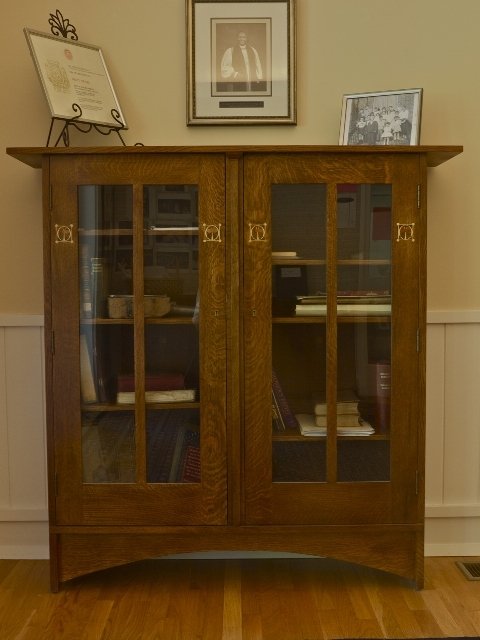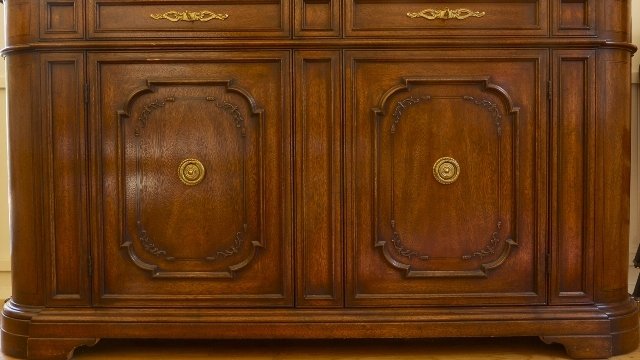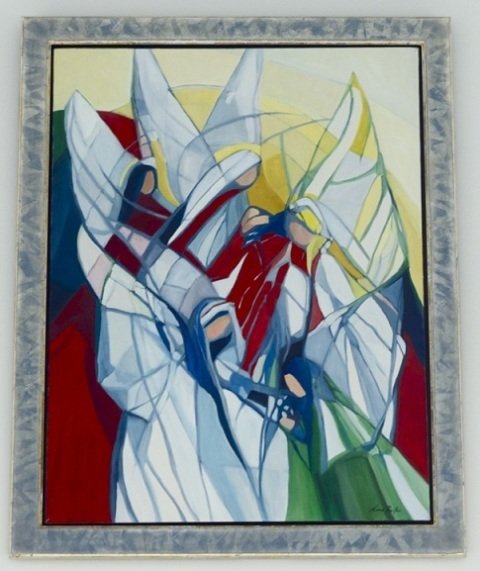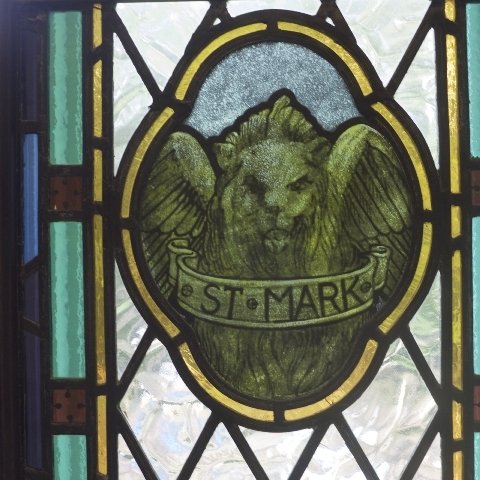
Furnishings & Memorials
The Parish House serves St. Matthew’s as a place for people to meet, sing, learn, engage in fellowship with one another, and manage the business and participate in the activities and programs which further the mission of the parish. The Rector’s study, the parish offices, and the Youth Room are located in the Parish House. The Cooke-Lawrence Room provides versatile space for meetings, receptions and other types of gatherings and events. It serves as a memorial to the parents of Bruce Lawrence and his wife, Miriam Cooke.
Please note that on November 24, 2020 the Vestry voted to rename the Ruffin House. It will be known as the Parish house at a minimum of 12 months.
The Ruffin House was named for Thomas Ruffin (1787-1870), a member of the first vestry of the parish and donor of the land upon which the church building is located. Ruffin remained a parishioner until the end of his life and is buried in the churchyard.
Ruffin is notable in North Carolina history for his career as a lawyer, planter and jurist. He distinguished himself in American jurisprudence during his long tenure as Chief Justice of the Supreme Court of North Carolina prior to the Civil War. He is perhaps best known for the opinion of the Court which he wrote in the case of State v. Mann (1829). In this opinion the Court sanctioned the rights of a slaveholder to absolute power over enslaved persons as chattel property, and decided that these rights extended, with impunity, to the point of inflicting physical injury through violence upon enslaved persons. This provocative decision became a central text in the abolitionist argument against slavery. In the introduction to her novel Dred, Harriet Beecher Stowe acknowledged Judge Ruffin and the Court’s opinion, which she incorporated verbatim in the novel.
Naming this building for Thomas Ruffin was intended to serve as recognition of his stewardship in bestowing the gift of property which continues to serve for the benefit of the parish today. It does not reflect tacit approval of his views on race and slavery, which we acknowledge as a matter of historical fact but repudiate. St. Matthew’s today is bound by our shared baptismal covenant of “seeking and serving Christ in all persons, striving for justice and peace among all people, and respecting the dignity of every human being.” (BCP, p. 305) The parish actively seeks opportunities to foster racial reconciliation and nurture its inclusive relationships with others without regard to race or color.
Constructed in 2000, the Parish House was designed by the Raleigh architectural firm of Frank Harmon and Associates, whose other notable public projects include the Walnut Creek Wetlands Center in Raleigh, the Education Center of the North Carolina Botanical Garden in Chapel Hill, and the North Carolina Pottery Center in Seagrove. The Parish House draws upon the inspiration of 19th century architects such as A.J. Downing, who adapted features of Gothic Revival architecture for rural settings and structures constructed of wooden materials. For his work in designing the Parish House, Frank Harmon received the Merit Award for the year 2000 from the North Carolina Chapter of the American Institute of Architects.
Foyer
Bookcase
The glass-fronted bookcase was given by Suzanne and William Powers, members of the parish, in 2003 in gratitude for his successful recovery from open-heart surgery. This cabinet is based on a design by Gustav Stickley, a manufacturer of furniture and the leading proselytizer for the American Arts and Crafts movement. It was produced by the Stickley Furniture Company with showrooms in High Point, North Carolina. It houses the parish Memorial Book and published works by members of St. Matthew’s. It is also used for the display of artifacts and items significant to the history and life of the parish.
Oriental Rug
The Fargo Hanna oriental rug in soft colors was originally given as a Valentine’s gift from the late Page Fisher to his wife, Joyce, who donated it in 2000 to St. Matthew’s. She recounted the weathering process for handmade rugs made in the Middle East. The rugs were finished, dyed and placed in the street to be walked on by children, camels, dogs and other animal traffic for one year. Then the rugs were cleaned and sold!
Sideboard
The sideboard after a design by Stickley was purchased in 2010 with memorial donations to complement the Stickley bookcase. Located directly beneath the bulletin board which displays news of current events, this piece provides storage space and its top serves as a practical and utilitarian surface space.
Armchairs (Pair), Piecrust table & lamp
The patterned chairs are from the Green & McClure Furniture Company in Graham, North Carolina. These Martha Washington chairs with fluted turned legs were selected in 2000 through the late Mary Lena Green Bacon’s connection to her father’s furniture company. She recalled playing as a child in that same store.
The mahogany piecrust table is an acquisition from the Payne Antiques shop in Hillsborough, North Carolina, with memorial funds during 2000.
The alabaster lamp was a gift from parishioners Deborah and William Kodros in 2000.
Photographs of Stained Glass Windows (Pair)
Two stained glass windows in the church building are the subjects of a pair of photographs by Alex Armstrong. The print to the left is usually called The Children’s Window, or more formally, ”Suffer the little children to come unto me.” The print to the right is often called The Mary and Martha Window, or formally “If ye love me, keep my commandments.” Alex Armstrong, formerly a native of Cary who now lives in Hillsborough, is an astro-photographer, specializing in highly technical low-light imagery. He credits his artist mother for his responsiveness to beauty. His photographs of St. Matthew’s are part of a series of Hillsborough scenes. He has said that he is very grateful to live in this community and that he is eager to give back whenever he can. Prints of a number of his photographs of subjects in the Hillsborough area have been hung in the old Orange County Courthouse, while some of his other photographs have been published in the 2012 Friends of the Eno calendar.
Cooke-Lawrence Room
Conference Table & Chairs
The conference table, chairs and credenza are key acquisitions for this room. The Millender family has had a long association with St. Matthew’s. Charles Millender’s parents were members of the parish and are buried in the churchyard. Charles, both of his children, and his sister were all married at St. Matthew’s. Charles made the pew racks for hymnals and prayer books at the request of Rector Bill Price to replace all of the earlier small, irregularly shaped racks shown in early 20th century photographs. The racks custom-made by Charles Millender have since been replaced during renovations to the church building in 2007-08.
Credenza
The Millender credenza was acquired because shortly after the table and chairs were delivered, we realized the need for a piece to use for storage purposes. We again consulted Charles Millender at his place of business. On the sales floor, a beautiful two-door walnut credenza, which he said was a one of a kind sample of an 18th century Italian design, was on display. This piece was stained and finished in the same manner as the conference table and chairs that the Millenders had donated for use in the Cooke-Lawrence Room. Mr. Millender kindly accommodated the parish on the purchase price, which was paid from memorial funds.
“Judaica”
Above the Millender credenza hangs a collage created by the paper artist, Galia Goodman, of Durham, North Carolina, who specializes in Hebrew and English calligraphy, paper-cutting and collage. This work, named “Judaica”, contains passages from the Book of Isaiah in both Hebrew and English. It was given by our Deacon, Katherine Johnson, in memory of her husband, Jeffrey, in 2008.
Brass Medallions
The handsome brass medallions are the work of the late John Rogers, an acclaimed artist and veteran of World War II. He originally struck two sets of medallions. One set is installed in the baptistry of St. Paul’s Episcopal Church in Grand Forks, North Dakota, where he was given the full responsibility for the design and decoration of the interior of the church building. In addition to his work on the baptistry, his design elements for the church included a mural depicting the River Jordan, cabinet and table, and many other decorations and design features. He mounted the second set of three medallions on a panel for hanging on a wall or for incorporating into another baptistry. He brought the second set of medallions with him to North Carolina. John Rogers designed the pentagonal wooden frame for the already mounted medallion panel. This frame echoes the design features from the wooden arch system above the organ at St. Matthew’s as well as the basic architectural design of the windows of the Parish House. After parishioner Miriam Saxon purchased the framed medallion panel as a gift to the parish, it was placed in the Cooke-Lawrence Room. Entitled “Rite of Baptism”, this piece is intended to represent the sacramental action of baptism itself: water, spirit, human and divine agency; the Holy Trinity—all present, all inseparable. Rogers chose two hands as the symbol of God in all His majesty rather than attempting to represent the face of the Divine in his work. The descending dove medallion symbolizes the Holy Spirit alighting upon Jesus at His baptism, while the hand cupping water symbolizes the action of baptism itself.
John Rogers also designed and fabricated the trefoil which graces the Parish House front porch.
Funeral Bier & Base
The funeral bier has an interesting three-part story:
History. The bier was ordered from Henry W. Jenkins & Sons, of Baltimore, Maryland. for use in burial services at St. Matthew’s. The Jenkins firm was a long established business that employed undertakers and furniture makers who reportedly made the casket for the remains of John Quincy Adams. The Jenkins firm designed and produced furniture from 1799-1904 and its products have graced prominent homes, public buildings and churches. It is possible that the design plans for the bier are archived among the business records of the firm which were acquired by the Winterthur Library near Wilmington, Delaware. Funds to pay the purchase price of $26.50 for the bier were raised by the ladies of the parish. The bier was delivered to the church on Monday, September 8, 1884, and it was used for the first time on Sunday, September 28, 1884, at the burial service for the Rector’s wife, Sarah Mary Matthews (Vaughn) Murphy.
Disuse and Discovery. Following a period of extended disuse, the bier was discovered by the Rev. Dr. Brooks Graebner, Rector of St. Matthew’s, in the belfry of the church building.
Restoration. Joyce and Page Fisher sponsored the restoration of the bier in 2000. At the recommendation of Susan Frankenberg, a member of the parish, the restoration work was performed by Virginia craftsman Barry Thompson of Southern Woodworking Company in Virgilina, Virginia. Mr. Thompson began the restoration work in 2000 by thoroughly cleaning and detailing the bier. He then created the base as a companion piece. He delivered the bier and base in 2001, following the untimely death of Page Fisher. A glass top was added for the protection of the bier when it is in use as a serving surface or for display purposes. This important piece with its later companion piece occupies a prominent place in the Cooke-Lawrence Room.
Painting of Church Steeple
Chris Graebner, a well-recognized artist in the Hillsborough area, is the wife of former Rector, Brooks Graebner. She works in oil and watercolors and is known particularly for her work with floral and botanical subjects, which she renders in remarkable detail. Her nocturnal painting in oil of the church steeple, hanging above the bier, is based on a photograph by their son, Martin. This painting was a gift of Jan and Rowen Grant in 2010.
Arm of the Cross
This piece is the only remaining arm of the cross which surmounted the steeple of the church building for more than a century. The cross was made of wood and clad in copper. The steeple and its cross were part of the expansion c. 1875 of the original church building, which had been consecrated in 1826. This first cross fell during a storm in 1979 and was replaced by the metal cross that has since been removed and mounted permanently on a base in the churchyard. The remaining arm of the cross is displayed on the bier where it complements Chris Graebner’s oil painting.
The white oak base that supports the cross-arm of the old steeple cross was designed and built in 2012 by Piedmont North Carolina furniture maker O’Neal Jones. Mr. Jones is a graduate of NC State University and a three time award-winning exhibitor of the Carolina Designer Craftsmen Guild.
“Guardians”
A beautiful oil painting by the late Norma Preston of Hillsborough graces the Parish House foyer. Following her death, this painting of a company of angels as its subject was given to the parish by her husband, Max Preston, a member of the parish, in January 2006. It hangs above the doorway leading to the foyer and it is lit to best display its brilliant colors and stained glass quality.
Here are Norma’s words describing her inspiration for this painting.
“My life was filled with angels—guardians of my way. One night I dreamed of a very large angel driving an old-variety open-topped Jeep approaching me across the grass prairie, its wings hanging outside the Jeep. I waited for what it had to say. Though it didn’t speak to me, I felt its joyful presence and I laughed to see it driving a Jeep.
My studio, in the Little Phoenix Mountains, above Jefferson, North Carolina, was a place for angels. It was nestled high on a mountainside, looking out on God’s creation.
The day that I began to paint the angels, it felt special—a mixture of calm and excitement. Angels came out of my brush like they were ready to jump onto my canvas. It seemed like a convention of angels. I painted spontaneously, moved by an energy that, I guess, was creation. And then it was done! When I stepped back to contemplate what I had painted, above the painting was an angel smiling down on me. It seemed to me that the angel approved of my work. I named the painting, ‘Guardians’.”
When the Parish House was completed in 2001, the Vestry recognized the need for appropriate furniture for meetings and other events in the Cooke-Lawrence Room. Charles Millender, whose family had previously owned White Furniture Company, was contacted and members of the Fine Arts and Furnishings Committee visited Millender Furniture at its showroom in Burlington, North Carolina. On August 8, 2001, a conference table with leaves made of matched mahogany veneer, with a 2½ inch satinwood border, set off by a black and white string inlay, was ordered. The twin pedestals are of hand carved mahogany, in the Sheraton (English) style with brass toecaps and coasters. Also ordered was the set of twelve mahogany side chairs consisting of near reproductions of a Sheraton chair by the shop of Anthony Hay, the master furniture maker of colonial Williamsburg. The original Hay chairs, from which the later copies were made, were produced c. 1760-1780, and are now in the Kenmore Museum in Fredericksburg, Virginia.
At completion and delivery, we were informed that this ensemble was to be a gift to the parish from the Millender Family. The parish gratefully accepted this generous gift.
Graebner Room
Bokhara Rug
The green Bokhara handmade rug was donated by Cecil and Grace McClees in 2001. With their long-standing background in music, they decided to make a gift that could be used in the Choir Room.
Service Area Connecting Foyer to Choir Room
Rug
The rug in front of the service counter is a Mir design, in black and beige. It was manufactured by Obeetee, a producer and exporter in India of fine handmade carpets, according to Fargo-Hanna Rug Gallery, a retailer of high quality Oriental rugs in the Triangle area.
This rug was a gift of Joyce Fisher in 2008.
Gallery
Runner
Joyce Fisher gave the red runner rug to the parish in 2008, in honor of the wedding anniversary of herself and her husband, the late Page Fisher.
St. Mark Stained Glass Window Sash
The stained glass window sash depicting St. Mark was a gift in 2002 from Jan Boyd Grant. She has said that since she was a child she has had a love of stained glass. Through the years, her interests have included shopping frequently at yard sales. In the Sterling/Leesburg area of Virginia, she attended a sale of antiques by a dealer who was closing her business to return to Europe. After finding the St. Mark sash among the other merchandise being offered for sale, Jan purchased it.
Ten years after acquiring the sash, Jan moved to North Carolina and hung it at her Lake Orange home in Cedar Grove. However, she has reflected that the entire time the sash was in her possession, she felt that she served only as its temporary custodian. When she met her husband, Rowen, and came to St. Matthew’s, she realized that the place for the sash was in one of the church properties. She decided to give it to the parish in memory of Rowen’s deceased wife, Joyce.
In giving the sash, Jan wanted it hung where it could be seen and enjoyed by many. Glenn Shultz, who made the front doors of the St. Matthew’s church building and the base of the baptismal font, cleaned the sash and hung it in the window outside the Rector’s study. Shortly thereafter, The Rev. Canon Jean Parker Vail, a priest associate of this parish, expressed her sentiments about how meaningful it was for her to vest near the window because of her connection to St. Mark’s Cathedral in Minneapolis, Minnesota.
In Jean’s words, “I was blessed to be Provost (Interim Dean) of the Cathedral Church of St. Mark in Minneapolis from 1994-1996―wonderful people, glorious music, magnificent Gothic architecture, superb liturgy―LOVED it! How kind of Jan to remember my having spoken about it.”
Bejar Rug
The Bejar rug from India was a gift of Joyce Fisher.




















